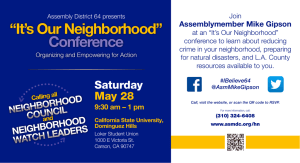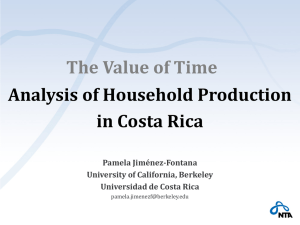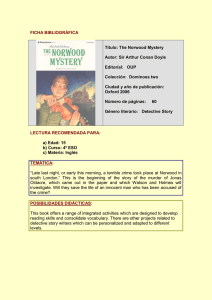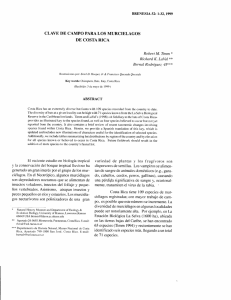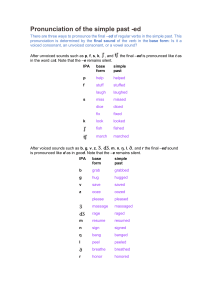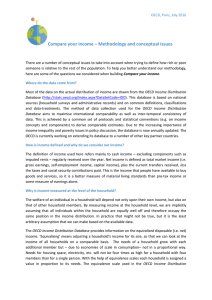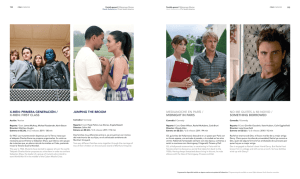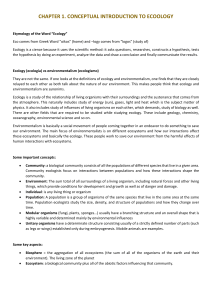Norwood The Nature of Knowing. Rachel Carson and American Environment
Anuncio
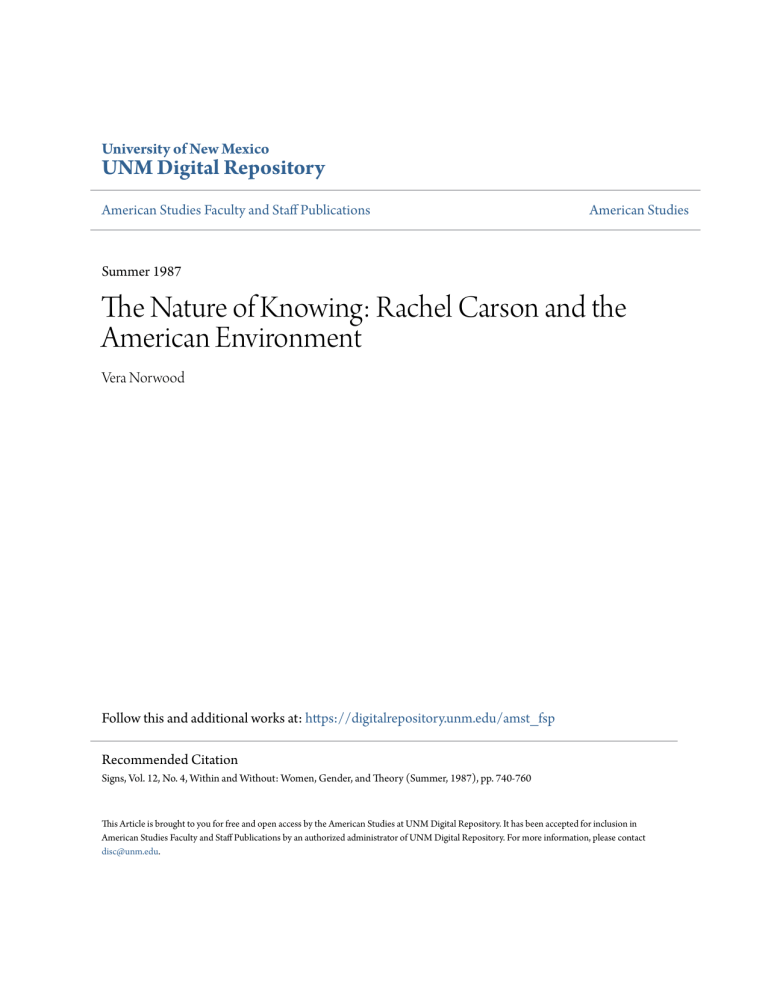
University of New Mexico UNM Digital Repository American Studies Faculty and Staff Publications American Studies Summer 1987 The Nature of Knowing: Rachel Carson and the American Environment Vera Norwood Follow this and additional works at: https://digitalrepository.unm.edu/amst_fsp Recommended Citation Signs, Vol. 12, No. 4, Within and Without: Women, Gender, and Theory (Summer, 1987), pp. 740-760 This Article is brought to you for free and open access by the American Studies at UNM Digital Repository. It has been accepted for inclusion in American Studies Faculty and Staff Publications by an authorized administrator of UNM Digital Repository. For more information, please contact [email protected]. The Nature of Knowing: Rachel Carson and the American Environment Author(s): Vera L. Norwood Reviewed work(s): Source: Signs, Vol. 12, No. 4, Within and Without: Women, Gender, and Theory (Summer, 1987), pp. 740-760 Published by: The University of Chicago Press Stable URL: http://www.jstor.org/stable/3174211 . Accessed: 07/11/2011 14:38 Your use of the JSTOR archive indicates your acceptance of the Terms & Conditions of Use, available at . http://www.jstor.org/page/info/about/policies/terms.jsp JSTOR is a not-for-profit service that helps scholars, researchers, and students discover, use, and build upon a wide range of content in a trusted digital archive. We use information technology and tools to increase productivity and facilitate new forms of scholarship. For more information about JSTOR, please contact [email protected]. The University of Chicago Press is collaborating with JSTOR to digitize, preserve and extend access to Signs. http://www.jstor.org THE NATURE OF KNOWING: RACHELCARSON AND THE AMERICANENVIRONMENT VERA L NORWOOD She sweeps with many-colored BroomsAnd leaves the Shreds behindOh Housewife in the Evening WestCome back, and dust the Pond! [EMILY DICKINSON, Poem 219, 1891] Emily Dickinson offers a succinct vision of woman's relationship with the natural landscape as one of housewife to home-one in which the poetic and the practical coexist. Although seemingly in keeping with gentle, domestic relationships with nature, in which the environment outside the home is experienced as a safe, tamed-garden version of the interior life Victorian women supposedly led, Dickinson's poem leads us to contemplate our definitions of female roles and the natural world, and the metaphors we use to understand our relationship to the world. As with most Dickinson poems, the image contains both text and subtext. The traditional role of Victorian women as household managers is subverted when the housewife inadvertently creates "dust"in her cleaning, and the leavings of her efforts enrich the world. Just as the image liberates women, it also liberates nature by suggesting that imperfection is as beautiful as perfection. [Signs: Journal of Women in Culture and Society 1987, vol. 12, no. 4] C) 1987 by The University of Chicago. All rights reserved. 0097-9740/87/1204-0004$01.00 740 Summer1987/ SIGNS As natural historian Carolyn Merchant has suggested, such metaphorical connections between women and nature have informed both the environmental movements and the feminist movements of this century. The strength of these connections rests on the image of earth as our "home." Environmentalists take many of their principles from the science of ecology, the meaning of which derives from the Greek oikos, or house. Merchant argues, "The connection between the Earth and the house has historically been mediated by women." She notes that many feminists find the image of earth as a female space to be a powerful one, and she argues that defining nature as organic "home" leads to concepts of interrelatedness, equal value to all parts, and increased sense of community. She cites biologist Rachel Carson as crucial to the shift away from a mechanistic worldview and toward an understanding of the organic home suggested by Dickinson's poem. Merchant comments further that the science of ecology and the feminist movement share a similar ethic characterized by an affinity with the concept of nature as home. The connotations of earth as a house, however, are not necessarily the same as those of the earth as home. In his history of developments in scientific ecology, Donald Worster explains that "oeconomy" was a term used to describe the knowledge later dubbed ecology. By the eighteenth century the phrase "oeconomy of nature" connoted "the rational ordering of all material resources in an interacting whole. God was seen both as the Supreme Economist who had designed the earth household and as the housekeeper who kept it functioning productively. Thus the study of 'ecology' ... was in its very origins imbued with a political and economic as well as Christian view of nature: the earth was perceived as a world that must be somehow managed for maximum output."2 Worster sees contemporary scientific ecology continuing to fulfill this economic, efficiency-, and production-oriented, managerial approach to nature.3 So, when Carson speaks of the earth as a house, we must be careful to note whether by house she means organic home, economic household, or some combination of both. Dickinson's poem suggests that, more often Carolyn Merchant, "Earthcare,"Environment 23, no. 5 (June 1981): 6-13, 38-40, esp. 6-11. 2 Donald Worster, Nature's Economy: The Roots of Ecology (San Francisco: Sierra Club Books, 1977), 37. 3 The dichotomy drawn here between Merchant and Worster is a bit simplistic: Merchant acknowledges the existence and continuation into the twentieth century of a managerial response to nature. However, she sees the ecological movement (including modern scientific ecology) as being more in tune with holistic "home"images than does Worster. Worster posits the managerial mode as integrally a part of the modem science of ecology and argues that visions of organicism in scientific environmentalism are a product, instead, of the popular understanding of ecology promulgated by "organicists"such as Joseph Wood Krutch and Alfred North Whitehead. See Carolyn Merchant, The Death of Nature: Women, Ecology and the Scientific Revolution (New York: Harper & Row, 1980), 290-95; and Worster, 332. 741 Norwood / NATUREOF KNOWING than not, home values and household values are intertwined in our daily relationships with the natural world. Consequently, her poetry resists the sort of pigeonholing that simplifies the complexity of her response to the world. Carson's work reflects a similarly complex view of the world in which neither the organic home metaphor nor the economic household metaphor alone describes our natural environment. Both Carolyn Merchant and Donald Worster credit Carson'swork with inaugurating recent environmental movements, but both also locate her writing squarely in the organic tradition that sees nature as home-with all the connotations, both for nature and women, that such a metaphor has.4 These historians are not alone in their assessment. Most commentators on Carson's works have tended to focus on her "nature writing," the pieces that celebrate the wonders of the natural world, and have ignored or trivialized the works that take a more economic, household-oriented approach, such as the materials she prepared for the U.S. government or much of The Sea around Us .5 Such work has been studied only to the extent that it is considered of the same "literaryquality" as her books; it has even been dismissed as evidencing an "enforced emphasis on utility."6 Carson, like Emily Dickinson, was much more in touch with the complexities of her world than such categorizing of her work indicates. Indeed, the metaphors of organic home and economic household reside in constant tension within all her work, even while Carson maintains that nature does not really fit into the conceptual boxes these metaphors supply. In fact, human beings encounter the world most often as trespassers, alienated from both the organic home and the economic household. Recognizing this failure of human pattern making to describe the natural world, Carson confronts the epistemological hubris involved in all naming and human pattern making. These issues are first raised in her classic nature books-Under the Sea Wind (1941), The Sea around Us (1951), The Edge of the Sea (1955).7These works, which shaped Carson's reputation as a nature writer and popularizer of ecology, are the pieces in which she struggled with the philosophical implications of standardliterary conventions for describing nature. In the late 1950s, the focus of Carson's concern shifted from the epistemological inadequacy of our understanding of nature to the consequences of such limited knowledge. She concludes by suggesting new norms for our relationship with the environment. This shift in emphasis 4 Worster, 23-24; Merchant, "Earthcare," 7. 5 Rachel Carson, The Sea around Us (New York: Oxford University Press, 1951). 6 See Paul Brooks, The House of Life: Rachel Carson at Work (Boston: Houghton Mifflin, 1971); Carol Gartner, Rachel Carson (New York: Frederick Unger, 1983); Wayne Hanley, Natural History in America (New York: New York Times Book Co., 1977). ' Rachel Carson, Under the Sea Wind, rev. ed. (New York: Oxford University Press, 1952), and The Edge of the Sea (Boston: Houghton Mifflin Co., 1955). 742 Summer1987/ SIGNS changes her usage of the metaphors as she investigates the negative facets of nature as home/household-the harm that the human nurturer and manager can inadvertently do. Silent Spring details this shadowy side of our dealings with nature. In this work, Carson evinces an understanding of the limits of human pattern making that suggests connections between her work and the then-emerging philosophical critique of positivism and objectivism, particularly Thomas Kuhn's conception of science as "paradigm" governed. 8 Carson realizes that paradigmshift occurs only when people are taught to see nature in new ways, so her last work emphasizes pedagogy; in The Sense of Wonder she offers a program for teaching children (and their parents) how to see nature as a system of processes rather than static conditions.9 Thus, I discuss the growing complexity in Carson'snature writing, her movement from philosophical to normative issues, and the connections of her work not only to the ecology movements of the sixties and seventies but also to major developments in the twentieth century in philosophy, particularly the philosophy of science. My analysis suggests not only a new reading of Rachel Carson's work but characterizes her as a major voice within contemporary discussions of gender and science as well. How women respond to the natural world, its meaning in their symbolic constructions of reality, and their own sense of responsibility to the environment at various times and among different cultures are matters of wide debate among scholars in such fields as history, literature, and anthropology. Important to this work is an understanding of the ways in which women use symbolic language-language sometimes perceived to spring from their socially derived roles-to relate to nature. I argue that Carson makes a strong contribution to rethinking and reshaping narrow constructions of nature and human relationships with nature implicit in symbolic language. In so doing, she also participates in a tradition reaching back at least to the poet Emily Dickinson and forward to Nobel Prize-winning biologist Barbara McClintock, a tradition celebrating not narrow, "domesticated" nature but the expanding conceptions of nature as home and family to include appreciation and respect for the uncontrollable, unknown-even the never-to-be-known-aspects of the world.'? 8 Rachel Carson, Silent Spring (New York:Fawcett, 1962);Thomas Kuhn, The Structure of Scientific Revolutions, rev. ed. (Chicago: University of Chicago Press, 1970). 9 Rachel Carson, The Sense of Wonder (New York: Harper & Row, 1965). 10Scholarly material on women and nature is scattered widely among the disciplines, with little cohesion or agreement to date. Good examples are Annette Kolodny, The Land before Her: Fantasy and Experience of the American Frontiers, 1630-1860 (Chapel Hill: University of North Carolina Press, 1984);Ann La Bastille, Women and Wilderness (San Francisco: Sierra Club Books, 1980); Carol P. MacCormackand Marilyn Strathern, eds., Nature, Culture, and Gender (Cambridge: Cambridge University Press, 1980);Carolyn Merchant, "TheWomen of the Progressive Conservation Crusade: 1900-1916," The Environmental Review 8, no. 1 (Spring 1984): 57-86; Sherry Ortner, "Is Female to Male as Nature Is to Culture?"in Women, 743 Norwood / NATUREOF KNOWING Under the Sea Wind is Rachel Carson's first book. Influenced by well-known nature writers like Henry Beston and Henry Williamson, the book is a series of classic tales about the migrationsof birds and fish over the span of a year. Carson identifies with the animals described and personifies them with names and human emotions." The Sea around Us established Carson as a natural history writer of the first order. The book was widely reviewed, quite popular, and earned a number of prizes.12 The Sea around Us catalogs most of what was understood about the world's oceans by the early 1950s, including what use humankind might make of the resources in the sea. Carson's third book, The Edge of the Sea, results from Carson's field research along the eastern U.S. coastline. Meant to be a guide or handbook, it became, instead, Carson'smeditation on the interrelatedness of land and sea life. The book melds her perspectives in Under the Sea Wind and The Sea around Us, treating both the animal life cycles and the geology of the coast. All three early works contain metaphoric uses of nature as home and as household. They also, however, often contradict those metaphors. Since the depiction of nature as home is the most common interpretation of Carson's work, I begin there. "Home" in this context means that there is a family feeling for the physical and biophysical landscape; it evokes the image of nature as our "mother," advocates an identification with other creatures, and promotes a unification of self and nature-that sense of being organically (as if by blood) related to the naturalworld-all of which leads to a reverence and respect for all the materials of one's home. In Carson's communities of creatures, nature is described as a mother creating a home for her children. These communities live on "homeplaces" in a naturallandscape, homeplaces that can even be constructed by animals who provide shelter for other animals (Under the Sea Wind, 84-85; The Sea around Us, 25-26; The Edge of the Sea, 55 and 101). Human structures also provide homeplaces for nature's flora and fauna, even to the extent that human landscapes of death become homes for life. For example, in Under Culture and Society, ed. Michelle Z. Rosaldo and Louise Lamphere (Stanford, Calif.: Stanford University Press, 1974), 67-87; Annis Pratt, "Women and Nature in Modern Fiction," Contemporary Literature 13, no. 4 (Autumn 1972): 476-90; M. Z. Rosaldo, "The Use and Abuse of Anthropology: Reflections on Feminism and Cross-cultural Understanding," Signs: Journal of Women in Culture and Society 5, no. 3 (Spring 1980): 389-417; MargaretRossiter, Women Scientists in America: Struggles and Strategies to 1940 (Baltimore: Johns Hopkins University Press, 1982); and Ann B. Shteir, "Women and Plants: A Fruitful Topic," Atlantis 6, no. 2 (Spring 1981): 114-22. For information on McClintock, see Evelyn Fox Keller, A Feeling for the Organism: The Life and Work of Barbara McClintock (New York: W. H. Freeman & Co., 1983). 1 Carol Gartner's recent study of the literary qualities of Carson's works provides a nice analysis of form and rhetoric in Under the Sea Wind. See Gartner, 29-47. 12 744 Brooks,126. Summer1987/ SIGNS the Sea Wind Carson vividly describes the killing efficiency of gill nets; later she offers her readers some relief from that horror by describing the gill net as homeplace: Tonight no fish would have tried to pass through the net, for all its meshes were hung with tiny warning lamps. Luminous protozoa and water flies and amphipods clung to the net twine in the dark sea, and the pulse of the ocean stirred from their bodies countless sparks of light. It was as though all the myriad lesser fry of the sea-the plants small as dust motes and the animals tinier than a sand grain-drifting from birth to death in an ocean of infinite size and endless fluidity, seized upon the meshes of the gill net as the firm reality in their uneasy world.... The gill net glowed as though it had life of itself.... The light lured many small creatures to rise from deep water and gather on the meshes of the gill net, where they rested all that night in the dark, wide sea. [Under the Sea Wind, 178-79]13 These are comforting images that offer an organic niche for humans in nature. By showing how the natural landscape might absorb the artificial structure, they defuse human destructiveness. Nature's ability to overcome human carelessness is a crucial concept for Carson, one she ultimately acknowledges to be false, but one to which she, nevertheless, was drawn throughout her life.14 The glowing gill net also reminds one that home can be a haven from the pressures of a harshly competitive world. Carson's first three books provide a litany of natural and artificial places becoming havens, particularly for babies (see esp. The Edge of the Sea, 84). Carson'spresentation of herself as a privileged visitor allowed to enter a unique and private world is important to this concept of nature as haven. For example, she describes a favorite tide pool as a place of gentleness and beauty eked out of an otherwise uncaring geological world (ibid., 3). Such a stance speaks directly to the protective atmosphere of home, including our naturalhome, as an organic, magical, life-affirming place. That said, we often come to the end of what is said about Rachel Carson's nature writing. For most of her critics, her love of nature is the backdrop and explanation for the intensity of feeling in Silent Spring. That she also mentions scientific developments in our knowledge of the sea, or "sneaks" in educational information about the oceans, or discusses the 13 For other examples of artificialhomeplaces, see Under the Sea Wind, 93 and 240, and The Edge of the Sea, 18 and 183. 14 A particularly beautiful statement of her loss of this belief is found in her 1958 letter to Beverly Knecht, quoted in Brooks, 9-10. 745 Norwood / NATUREOF KNOWING technicalities of the fishing industry is secondary to her reverent picture of nature as home. But there is another side to Carson'shome metaphor, one fed not by her reading of classic nature writers but by her training as a scientist. Charles Darwin is not often mentioned as a source for Carson's writing, but she draws on him frequently in The Sea around Us. Both The Sea around Us and The Edge of the Sea reflect scientific ecological concepts that came out of the merger in the early twentieth century of biology and geology. Much of Carson's college training in biology must have been grounded in Frederic Clements's climax theories. Charles Elton, who first described food chains and wrote about the ecology of land animals, provides the fundamental web of interconnections behind Silent Spring."5 As Donald Worster notes in Nature's Economy, the primary implication of the "well-managed household" is an economic one. Worster traces a convincing history of the connections between science and industrial society over three centuries, based on an economic ideal of progress that culminates in the mid-twentieth century in a "New Ecology." The New Ecology begins with Charles Elton's food chains. Animals and plants are categorized as producers, consumers, reducers, and decomposers: "These labels emphasized the nutritional interdependence that binds species together-the corporateness of survival-and they became the cues from which ecology would increasingly take an economic direction. "'6Although the New Ecology resulted in a decreased interest in Darwinian competitive struggles, Worster is careful to show how new scientific breakthroughs arose from earlier tendencies to regard nature as a factory of sorts and humans (rather than God) as supreme managers.'7 Rachel Carson learned science and wrote her early books in the midst of the changing vision of nature Worster delineates. Thus her well-managed household looks both back to Darwin and forward to what Worster calls "pacified" nature. Further, in describing nature as an economic household, Carson, as she had done in describing it as a home, looks at the metaphor both as descriptive of the biophysical environment we see around us and as revelatory of our place within that environment. Although all three books offer fulsome examples of the interplay, in the natural world, between competition and "corporateness," Under the Sea Wind offers a particularly illustrative case of the natural world and man's "5Worster (n. 2 above), 200-214, gives a clear summary of the scientific climate that doubtless nurtured Carson, with a particularlygood description of Clements's contributions to ecological thought at the time. Donald Fleming details other sources of Carson's scientific thought in his "Rootsof the New Conservation Movement," Perspectives in American History 6 (1972): 7-91, esp. 28. 16 Worster,296. 17 Ibid., 312-15. 746 Summer1987/ SIGNS impact on that world-a dramatization of men hunting mullet.18Initially Carson evokes the high drama of the battles between men and their prey, the uncertainties of the chase on both sides, but she concludes with the image of a well-regulated, cooperative household. Men discard mullet "too small to sell, too small to eat"; the sea carefully "laps"up some of these for "the hunters of the tide lines," the ghost crabs and sand hoppers who then come out to clean up the debris: "for in the sea, nothing is lost. One dies, another lives, as the precious elements of life are passed on and on in endless chains." Significantly, men have not altered the balance of life here as many "mullet [pass] unmolested through the inlet and [run] westward and southward along the coast" (Under the Sea Wind, 95-102). In sum, Carson'swork reveals a much more conflicted and complicated approach to nature than her reputation gives her credit for. Donald Worster's placement of Carson in the "arcadian"tradition-assuming identification with the natural world as the proper human response-is a classic example of the general tendency to emphasize only her reverence for nature. 19Carson, however, understands the economic imperatives too well to render only the solution offered by arcadia. A brief story from her first book epitomizes the tensions in her work, revealing how each of us continually balances the organic home and economic household meanings we find in nature. The story tells of a failed catch seen through the eyes of a young fisherman so new to the occupation that he is still filled with an "unslakable curiosity" about life under the sea's surface. He has family feeling for life in the sea: "It seemed to him incongruous that a creature that had made a go of life in the sea . .. should at last come to death on the deck of a mackerel seiner." Nevertheless, he is stuck with the economics of the household, with the inalterable fact of his own need to consume: "It was only later, when they had finished the long, wet task of repiling the 1200-foot length of seine in the boat, their hour's heavy work wasted, that he realized what it meant that the mackerel had sounded" (Under the Sea Wind, 200-203). Thus Carson alternates between a vision of nature as revered, respected homeplace, to be approached with an almost religious curiosity and as a household existing primarily for production, consumption, cooperation, and management.20 More often than not, however, Carson is struck by the degree to which 18 For other examples, see the story of Scomber, a baby mackerel in Under the Sea Wind, 129-46; comments on the "fierce uncompromisingness" of the sea in The Sea around Us, 17; and predator/prey relationships in The Edge of the Sea, 55-57 and 109. 19Worster, 23-24. 20Gartner's comment that Carson emphasizes the earth as "an interlocking whole where nothing is wasted" (n. 6 above), 60, is common to all her critics. That such a vision could include an economic as well as organic appreciation has not been recognized. 747 Norwood / NATUREOF KNOWING the natural world does not function as home or household for its human children. Finding herself and her fellows to be outsiders, trespassers in a world that is distinctly "other," she declares both nuturing and managerial responses to nature doomed to miss the point. The occasions when she fails to find herself at home in nature, paradoxically,constitute the high points of her experience. Similarly, the occasions when the economic metaphor shatters against the unwillingness of the naturalworld to "produce"meaning provide her most telling critiques of human limitations and lead her to doubt all "naming," all artificialboxes into which nature has been "fit." In this context, Carson becomes more than a nature writer; she raises fundamental questions about how human knowledge is constructed, questions that reveal the epistemological hubris underlying much human understanding. These questions prompt her later normative work in Silent Spring and The Sense of Wonder. The first paragraph of Under the Sea Wind begins with a metaphor questioning easy assumptions about categories-in this case distinctions we normally make between land and ocean: "Bothwater and sand were the color of steel overlaid with the sheen of silver, so that it was hard to say where water ended and land began" (3). The images suggest that the places where ocean meets land will not always conform to visions of a warm, life-giving mother from which all life sprang; this ocean is also cold, borderless, impermanent, and harsh with its living inhabitants. Such uneasiness about the exigencies of the ocean expressed in the opening paragraph of her first nature book flow through all three books. Carson constantly points out the risks in an environment that requires enormous waste of life. She notes, for example, the thousands of young who die in the ocean for lack of a fortuitous piece of driftwood or buoy to make into a homeplace (The Edge of the Sea, 188). Her concern is only increased by the tenuous security of these places-so easily destroyed by storms or tides (ibid., 64-65). What are we to make of the mole crab, who lives but one year, dying at the end of the summer, leaving just one generation to tenant the household (ibid., 156)? Or of the sea cucumber spewing forth its internal organs when threatened (ibid., 229)? Looking at such a world, Carson can only note how strange it appears to human observers, how deficient we are in comprehending its reason. Carson's writings are filled with allusions to the separation between humans and nature. In the most mundane examples, human beings are trespassers, physical intruders. In Under the Sea Wind the appearance of fishermen "alarms"a heron, sends shore birds scurrying toward the sea, sets the terns to flight "like hundreds of scraps of paper flung to the wind," and lands a ghost crab into the jaws of a channel bass (34-35). On a wider scale, the arrival of people in the delicate ecology of islands "abruptly changes," "exterminates," "ruins," and "snaps the slender thread of life" for many species (The Sea around Us, 94-95). Further, Carson laments 748 Summer1987/ SIGNS that in important ways humans literally cannot see nature, and she constantly points out the physical limitations of our ability to grasp the world we so blithely call "home." Looking at a tidepool, she remarks, "The human imperfection of my vision . . . prevented me from seeing those microscopic hordes that . .. seemed to me the most powerful beings in the pool"(TheEdge of the Sea, 116-17). Humans need mediating symbols (literal and figurative) in their attempts to make the natural world comprehensible. Technology, for example, symbolizes literally the need for some intervening device to aid our limited faculties. The Sea around Us is as much about such devices as about the sea itself: "Moving in fascination over the deep sea he could not enter, [man] found ways to probe its depths, he let down nets to capture its life, he invented mechanical eyes and ears that could recreate for his senses a world long lost" (15). A specific example of such technology is the development of wave recorders, allowing us to "read" the language of waves that warns us of storms-an ability, Carson notes, that technology has reclaimed from the skills of earlier peoples (ibid., 115). While such technologies allow for better readings of nature, they do not necessarily lead to an imperial dominance. We can now measure waves, but they still "may engulf lighthouses, shatter buildings, and hurl stones through lighthouse windows anywhere from 100 to 300 feet above the sea" (ibid., 123). Thus technology may help humans cope with their limitations, but it does not harness nature. Figurative symbols, the meanings we give to natural phenomena, are undercut in similar fashion. A chapter on ocean seasons in The Sea around Us is an impressive exercise in the creation and destruction of simile and metaphor, ultimately pointing out the inadequacy of symbolic language. Carson first compares spring on the land and in the sea: "In the sea, as on land, spring is a time for the renewal of life" (The Sea around Us, 29). Much of the description depends on the economic household metaphor. She stresses the efficiency of the process of winter survival in the sea and the re-creation of food chains as smaller life forms begin to multiply in the spring warmth. Agricultural images multiply as she describes the ocean's "hills" and "valleys," the plankton "grasslands,"and "grazing"fish (ibid., 30). These images continue to arise throughout the chapter, but a new set, stressing the "strangeness"of the seascape, also appears. Suddenly we are confronted with repulsive and nonproductive processes: "The diatoms become more and more scarce, and with them the other simple plants. Still there are brief explosions of one or another form, when in a sudden orgy of cell division it comes to claim whole areas of the sea for its own. So, for a time each spring, the waters may become blotched with brown, jellylike masses, and the fishermen's nets come up dripping a brown slime and containing no fish" (ibid., 30-31). The creatures of this place are not like land creatures but are of another world; they glow and their phosphores749 Norwood / NATUREOF KNOWING cence causes "fishes, squids, or dolphins to fill the water with racing flames and to clothe themselves in a ghostly radiance" (ibid., 32). Natural metaphors no longer suffice. As the seascape becomes increasingly problematic, Carson resorts to descriptions of sea surfaces glowing "with sheets of cold fire" and fish pouring "through the water like molten metal" (The Sea around Us, 33). Finally, the ocean is neither home nor household but an ominous place lit by a tiny plant "that contains a poison of strange and terrible virulence" (ibid., 33). It is a place whose meaning must be decoded-in this case by the Indians of the Pacific coast who warn illiterate inlanders of the dangers the ocean poses. Carson's aim here is not simply to write naturalhistory; having evoked and discarded various figurative meanings given to the sea, she also then questions the adequacy of our pattern-making minds: "Man, in his vanity, subconsciously attributes a human origin to any light not of moon or starsor sun. Lights on the shore, lights moving over the water, mean lights kindled and controlled by other men, serving purposes understandable to the human mind. Yet here are lights that flash and fade away, lights that come and go for reasons meaningless to man, lights that have been doing this very thing over the eons of time in which there were no men to stir in vague disquiet" (The Sea around Us, 34). Showing such a need to find meaning or make patterns out of natural phenomena afflicts us all, she concludes with quotations from Charles Darwin and Joseph Conrad on anarchy in the autumn sea and death in the winter sea, respectively, using Darwin's and Conrad's figures to set up her own closing affirmationof life: "The lifelessness, the hopelessness, the despair of the winter sea are an illusion. Everywhere are the assurances that the cycle has come to the full, containing the means of its own renewal" (ibid., 36). In this essay on seasons of the sea she measures the ability of language, even in its most flexible expression in figures, to adequately provide a symbolic match to the protean environment. It is only as we see our similes and metaphors constantly giving way before change that we approach an understanding of nature.2' Rachel Carson's questioning of the correspondence between human patterns and the natural world results from her own experiences with epistemological hubris. In fact, it is when she fails to find expected patterns that she has her most meaningful experiences. In the first chapter of The Edge of the Sea Carson explains why the shore continually attractsher. The two most important qualities of that place for her are a "sense of remoteness" and its fascination as "a world apart"(4). To experience these qualities, she seeks that place of constant change that has always troubled 21That Carson consciously works to break down such illusion is made clear in a statement from "Our Ever-Changing Shore," an essay she wrote in 1958 to encourage preservation of wild shores: "The ocean has nothing to do with humanity. It is supremely unawareof man, and when we carrytoo many of the trappingsof human existence with us to the threshold of the sea world our ears are dulled and we do not hear" (reprinted in Brooks [n. 6 above], 219). 750 Summer1987/ SIGNS her-the tide line-not during the day, but at night, to find "a different world, in which the very darkness that hides the distractions of daylight brings into sharper focus the elemental realities" (ibid., 5). Humans seem to be one of the distractions. For Carson, the blackness of the night is "the darkness of an older world, before Man." In this nonhuman place, with the aid of the intrusive beam of a flashlight, she "surprises"(or trespasses on) a small ghost crab. The crab seems to be the only life on the beach. The night, the individual crab, the alien seascape all conspire to deny her a comfortable sense of identification with the world she sees. This disjunction with nature elicits an epiphany: "I have seen hundreds of ghost crabs in other settings, but suddenly I was filled with the odd sensation that for the first time I knew the creature in its own worldthat I understood, as never before, the essence of its being. In that moment time was suspended; the world to which I belonged did not exist and I might have been an onlooker from outer space" (The Edge of the Sea, 5). This is not the identification with animal life so commonly attributed to Carson but, rather, a recognition of the impossibility of such identification. Nor is she engaged here in finding transcendent meaning in nature by moving outside her own skin, forgetting herself; she removes human culture but not the consciousness necessary for recognizing nature's "otherness. "2 The symbolic meaning she gains from such experiences is bound up in process rather than utility, either emotional or economic. The ghost crab experience obliterates the sense of community that can make us feel too much at "home" in the natural world, too able to understand, identify, or control. The crab becomes a symbol of life-"the spectacle of life in all its varied manifestations .... Underlying the beauty of the spectacle there is [elusive] meaning ... that haunts us, that sends us again and again into the natural world where the key to the riddle is hidden" (The Edge of the Sea, 7). This grasp of the "elusive," "tantalizing,""obscure," "inscrutable" meanings of nature, coupled with her understanding of the very human need to make patterns, is the basic source of the trespasser images. For Carson, one of the most important aspects of human interaction with nature is the realization that the protean quality of the naturalworld cannot be caught by our pattern-hungry minds but that it is our "nature" continually to seek the pattern. In these early books, this fact provides a sort of delicious frustration for her. Aiming to describe both beautifully and accurately the sea- and landscapes, she builds some of her most evocative 22In his otherwise perceptive commentary on Carson, Fleming identifies her as a transcendentalist engaged in "self-forgetfulness before nature." He further states that her response to nature entails "fantasiesof personal obliteration," citing this passage as an example (12-13). Carson may be obliterating the artificialhuman world here, but she is certainly not denying her separate existence as an individual human; that, in fact, is a significant part of the equation between herself and the ghost crab. 751 Norwood / NATUREOF KNOWING prose out of foiled attempts at symbolization and categorization (esp. ibid., 123, 250). By the late 1950s Carson becomes less intrigued by this recognition; knowing that much human destruction results from not understanding nature's protean quality, Carson becomes increasingly concerned about the havoc human trespassers wreak. Faced with the crises of pollution and the nuclear age, her writing increasingly critiques human "nature," delineating our limited knowledge rather than celebrating nature's lessons. Rachel Carson always saw humans as trespassers and breakers, but only post-World War II American industrializationeducated her to the massive threat this antagonistic charactercreated for the "other"world, the nonhuman world. When she understands this, her writing takes a polemic turn. The three visions of human and nature interacting-as family in a home, as manager in a household, and as trespasser in an alien world-continue to appear in her writing, but they are depicted with a malevolent facet, introducing the reader to the destructive interactions that take place when homemakers and household managers become sick or corrupted. Recognizing the extent of the malady, Carson's writing shifts to a new, actionoriented concern for "right" understanding, the correct relationship between humans and the rest of the natural world. The Sea around Us concludes with an upbeat vision of humans' "acquisition" of the resources of the ocean. When Carson revised the book ten years later in 1961, she added a preface that outlined the most recent achievements of science and technology in increasing our knowledge of the sea. Some of the most interesting discoveries pointed to the profuse interconnections between sea and land, fostering a concomitant change in our image of the deep sea from a place of relative stability to an environment of dynamic movement. Carson particularlyfeared the growing use of the oceans as radioactive dumps, and she explained how the dynamic sea may distribute radioactive contaminants through the movement of currents and the action of food chains. Carson was outraged by those who act on insufficient knowledge and forget the ghost crab's lesson: we are limited in our ability ever to comprehend truly the protean land- and seascapes in which we live. Thus, the preface ends on an ominous note that questions the notion of nature as home or household: "It is a curious situation that the sea, from which life first arose, should now be threatened by the activities of one form of that life. But the sea, though changed in a sinister way, will continue to exist; the threat is rather to life itself. "23The sea is no beloved mother, nourishing 23Rachel Carson, The Sea around Us, rev. ed. (New York:Oxford University Press, 1961), xiii. The biblical quality to Carson'spreface, reminiscent of the jeremiad sermon, is examined in Vera Norwood, "Heroines of Nature: Four Women Respond to the American Landscape," Environmental Review 8, no. 1 (Spring 1984): 34-57, esp. 46-47. 752 Summer1987/ SIGNS life, passively accepting, absorbing and redirecting the changes her children go through; neither is the sea an endless factory of resources (or, in this case, storage places). It is "other" than humankind and as such may return our trespasses back on us in totally unexpected ways. The sea is not the only natural terrain offering unpleasant surprises for human development. Although Carson sometimes uses the disjunction between humans as land creatures and the sea to develop that outsider persona, she finds a similar lack of connection between humans and all the nonhuman naturalworld. Silent Spring, the book following her revised The Sea around Us, offers stunning descriptions of the unpleasant surprises nature contains for twentieth-century household managers and homemakers. The book begins with an arcadianfable in which a group of settlers has developed the "middle-landscape," the American dream of home in nature, but the dream has soured: "Some evil spell had settled on the community: mysterious maladies swept the flocks of chickens; the cattle and sheep sickened and died. Everywhere there was a shadow of death" (Silent Spring, 13-14).24As she lists the various deaths, Carson constructs the lifeless landscape she foretold in the preface to The Sea around Us. Limited in their understanding of the ecosystem, the settlers have no idea what is bringing the end to life. Carson argues that they have done it themselves in the attempt to "improve" on their home, to increase the comfort of their middle landscape (Silent Spring, 14). In this example, Carson uses both home and household metaphors to emphasize the settlers' attitudes of care toward their natural home and their management approach toward the environment. But her ultimate explanation of the community's demise is that, despite their good intentions, they are unable to see or conceptualize the complex intricacies of their ecosystem. The ecological concept against which home and household metaphors are tested is the landscape's resistance to life, the idea that nature requires waste, impurity, accommodation, and seeming inefficiency in order to thrive. With this understanding as a constant backdrop, Carson redefines the household management and home care metaphors. Those acting on the notion of earth as a household modeled on industrial economics do not even understand good management, according to Carson. In Silent Spring she takes up the burden of their education by redefining productivity and efficiency. Basically, she questions the value of progress toward ultimate goals, as well as the managerial ethos informing most 1950s' discussions of how to improve production in nature. Her analyses of "progress"in scientists' attempts to control the gypsy moth and the fire ant are examples of her manipulation of the economic household 4 On the "middle-landscape" and American culture, see Leo Marx, The Machine in the Garden: Technology and the Pastoral Ideal in America (New York:Oxford University Press, 1964). 753 Norwood / NATUREOF KNOWING metaphor. For both of these pests, new insecticides were hailed as offering the opportunity to create a perfect environment-one with no "noxious" insects. Expensive and technologically demanding campaigns using these insecticides, however, destroyed or contaminated crops and other agricultural products such as milk and honey, made no change in the gypsy moth population, and led to an increase in the fire ant population. Further, Carson argues that less "sophisticated"methods, not requiring large-scale management techniques, are not only more successful at control but are also less expensive (Silent Spring, 142-56).2 Thus, Carson shows no sympathy for development that assumes a passive landscape, a landscape incapable of responding (in often surprising ways) to human intentions. That is the lesson she offers to household managers. Our ability to know how efficiency and productivity are best served in our interactions with the landscape is limited by our ignorance of the complex, interconnected economies disrupted by any intrusion (ibid., 48-49, 59, 217-20). Just as Carson in Silent Spring both employs and questions the economic approach to nature, she also manipulates reverent, homeplace figures of nature. Those who attempt to identify human nature with the natural world are warned that "home" is in fact no haven from a harsh world. The interconnectedness of all life becomes sinister as we come to understand the webs of death interwoven with the webs of life. Throughout Silent Spring Carson emphasizes nature's complex system of checks and balances, which limits as well as nurtures species. Although humankind's interference, in the form of technological manipulations, may change the movers, the shift to regain balance continues, affecting not only the offending insects in the examples above but the whole chain of life and death. From this perspective "home" becomes a place of nightmares.26 In the early books, Carson offers fascinating glimpses of developing embryonic life, of the growth and survival of animals in that resistant natural world, and of the lives of animal babies. In Silent Spring she continues the theme but considers the ominous possibilities natural processes contain. For example, Carson uses robins, those common harbin- 25Fleming (n. 15 above), 87, notes that the "New Conservationists"of the 1960s (Carson among them) "were basically hostile to utopian schemes in general" and cites Carson's description in Silent Spring of government-inspired "nightmare"utopias of eradication. 6 Merchant (n. 1 above) comments that "the home is ... no longer a haven" because of the intrusion of deadly chemicals into the indoor environment (10). That the concept of home as a separate environment, a place inviolate to the outside world, is a powerful metaphor in American culture has been amply demonstrated in such works as Christopher Lasch's Haven in a Heartless World (New York: Basic Books, 1977). Carson's deconstruction of the home metaphor not only suggests that human homes have been violated by our own poisons but further questions the anthropocentric stance that assumes human environments ever were separable from the rest of the environment. 754 Summer 1987 / SIGNS gers of spring, to show how insecticides work in food chains.27Using to her advantage her readers' family feelings toward these yard and garden friends, she leads us through the technical processes by which insecticides affect cell formation as she describes a robin's nest with its "complement of blue-green eggs" lying cold, "the fires of life that flickered for a few days now extinguished." Carson explains that radiation, insecticides, and pesticides interfere with the availability of ATP (adenosine triphosphate, a crucial energy "battery"for cell division) in embryos; she then relates this phenomenon to human life, to our membership in the robin family: "There is no reason to suppose these disastrous events are confined to birds. ATP is the universal currency of energy, and the metabolic cycles that produce it turn to the same purpose in birds and bacteria, in men and mice" (Silent Spring, 184-85). A litany of the genetic implications of combined, longterm contact with radiation and chemical poisons concludes the chapter. Thus, using images of common, valued animal life, Carson delineates the consequences of human interference in nature for all life. In this scenario of nature as home we are indeed members of a family, and the death we bring is visited as well on all the family members. Carson does not deny the metaphor of earth as home but, as she does for the economic household metaphor, cautions against interpreting its meaning too simplistically. In the final analysis, Silent Spring really is not about nature; rather, it is a close look at the limitations of human trespassing on nature. The problem Carson pursues throughout the book is that "nature has introduced great variety into the landscape, but man has displayed a passion for simplifying it" (20). Silent Spring begins with a people too "single-minded" to understand the effects of their own actions. For example, our sense of the destructive potential of poisons pales when packages of deadly weed killer are illustrated with "a happy family scene, father and son smilingly preparing to apply the chemical to the lawn, small children tumbling over the grass with a dog" (ibid., 161). The real difficulty with such symbols, the underlying assumption that makes them too simplistic, is that they describe only what the chemical creations seem to mean to humans-a better life, increased comfort in our present "home." Such exploitation of the home and household metaphors allows those who use the chemicals to avoid moral responsibility, to justify their activities by basing them on biophysical "laws"that imply humans are only fighting to survive and, in keeping with post-Darwinian ecology, are participating in natural processes of biological succession by helping to "improve" the environment. 27 Although Carson's reliance on food chains leaves her argument open to attack, most commentators feel that there is sufficient truth to her claims that such criticisms do not deny the strength of Silent Spring's statement. Fleming gives a clear assessment of the relative strengths and weaknesses (from a purely scientific viewpoint) of this aspect of Carson's book (32). 755 Norwood / NATUREOF KNOWING Paradoxically, Carson found in our role as trespassers an escape from the seemingly inevitable image of humans as carriersof death and destruction. We are trespassers in large part because of our self-consciousness, our pattern-making minds; we may be of nature, but that observing awareness, a function of culture, also separates us from the environment. The case Carson ultimately makes for gentler dealings with the environment rests on distinctions she makes between nature and culture. Discussing the use of nonselective poisons, she comments that such substances poison "alllife . . . the cat beloved of some family, the farmer's cattle, the rabbit in the field, and the horned lark out of the sky. These creatures are innocent of any harm to man. Indeed, by their very existence they and their fellows make his life more pleasant. Yet he rewards them with a death that is not only sudden but horrible. ... By acquiescing in an act that can cause such suffering to a living creature, who among us is not diminished as a human being?" (Silent Spring, 95-96). That we do see patterns in the ecosystem is thus a curse and a blessing; we are condemned to feel like eternal outsiders to our household/home, but we are also gifted with a curiosity and comprehension apparently available to no other creature.28Unfortunately, Carson could not find this gift adequately developed in the American culture of her time. While most commentators feel Silent Spring ends on an upbeat note, with Carson's much-discussed case for reliance on and development of natural controls, in fact her last statement is a less than hopeful analysis of the current state of scientific culture:29"The 'control of nature' is a phrase conceived in arrogance, born of the Neanderthal age of biology and philosophy, when it was supposed that nature exists for the convenience of man. The concepts and practices of applied entomology for the most part date from that Stone Age of science. It is our alarming misfortune that so primitive a science has armed itself with the most modern and terrible weapons, and that in turning them against the insects it has also turned them against the earth"(261-62). Silent Spring ends with an image of failed evolution. The twentieth century merely added new forms of technology to the imperial philosophy that has not changed and continues to operate. Silent Spring concludes on this negative note in part because the change in research that Carson prescribes can come about only through what Kuhn would call a "paradigm shift" in the way Americans view the environment.30 Lack of adequate symbolism, not lack of knowledge, is the 28The nature/culture split is, of course, the subject of endless comment and conjecture. I am concerned here with the meaning such a split might have for the development of symbolic language. In this light I find most useful Victor Turner's comments in Dramas, Fields, and Metaphors: SymbolicAction in Human Society (Ithaca, N.Y.: Cornell University Press, 1974), 31-32. 29See Fleming, 32-33; Gartner (n. 6 above), 91. 30Paul Brooks notes that Carson was "not only questioning the indiscriminate use of poisons but declaring the basic responsibility of an industrialized, technological society 756 Summer1987/ SIGNS issue; we continue to look for simplicity and regularity instead of recognizing that nature cannot be conceptually tamed through metaphor. Whether we define nature as a loved home or as an economic household is moot; either metaphor leads to a comfortable and misleading sense of familiarity. We need a paradigm that acknowledges flux and surprise as well as regularity and stasis. The only way to effect such a change is to teach the next generation adequate seeing. Carson has a specific sort of vision in mind: "We see with an understanding eye only if we have walked in the garden at night and here and there with a flashlight have glimpsed the mantis stealthily creeping upon her prey.... Then we begin to feel something of that relentlessly pressing force by which nature controls her own" (Silent Spring, 220). This statement echoes the earlier images of the beach walker trying to understand the tantalizing meaning of the ghost crab or the observer marveling at millions of diatoms flashing in the ocean. Experiencing the naturalworld as resistant to human pattern making changes the paradigms, moves us beyond Neanderthal philosophies. Near the end of her life, Carson turned to this image of tantalized observer. She hoped to expand "The Sense of Wonder,"an essay she wrote in 1956, into a book for parents that would help them encourage an appreciation of nature in their children. The text of the essay, and a set of complementary photographs, was published as a book shortly after her death. "Wonderment" means a continuing surprise and curiosity about the environment. As might be expected, the quintessential time and place for such an experience in Rachel Carson'sworld is on a beach at night; so The Sense of Wonder begins with Carson and her nephew, Roger, standing "one stormy autumn night . .. out there, just at the edge of where-wecouldn't-see" (8). Immediately following, we see them searching the beach with a flashlight for "those sand-colored, fleet-legged beings," ghost crabs (ibid., 10). Throughout she emphasizes the need to move away from comfortable, assumed visions of the envir'onment and to see it as new, astounding, unusual. Building off the comment, "How can I possibly teach my child about nature-why, I don't even know one bird from another" (The Sense of Wonder, 45), Carson argues that adequate seeing and feeling are more important than the ability to label and categorize the environment. What she hopes to build in the next generation is a grasp of naturalprocesses, not static landscapes (ibid., 82). So The Sense of Wonder is process oriented: "There is symbolic as well as actual beauty in the migrationof the birds, the ebb and flow of the tides, the folded bud ready for the spring. There is toward the natural world" (see Brooks, Speaking for Nature: How Literary Naturalists from Henry Thoreau to Rachel Carson Have Shaped America [Boston: Houghton Mifflin Co., 1980], 285). For Kuhn's comments on the nature and meaning of paradigm shifts, see Kuhn (n. 8 above), 92-110. 7S7 Norwood / NATUREOF KNOWING something infinitely healing in the repeated refrains of nature-the assurance that dawn comes after night, and spring after the winter" (ibid., 88-89). That she is not describing any mechanical, knowable environment in noting such "refrains"is made clear by the conjoining, concluding vision of two people-both in their ninth decade of life-who maintain an infinite curiosity about the changing meanings of these rhythms (ibid., 89-95). Carson recognizes the extent to which burgeoning scientific knowledge displaces the lay person from viable, confident experiences of nature. The Sense of Wonder ends with an absolute assertion of the availability of the environment to anyone "who will place himself under the influence of earth, sea and sky"(95). Carson'svoice in all her books-her persona, if you will-is unequivocally allied with the nonspecialist. The most sophisticated instruments of technology we ever hear of her using are a flashlight, a magnifying glass, and (infrequently) a microscope. With all her appreciation of the technologies that "open" the natural world to our understanding, she is extremely cautious of supporting our tendency to go too far "into an artificial world of [our] own creation. "31 It is impossible to find her speaking with a voice of superior authority; always her experiences are available to the general reader. In Silent Spring, the book most dependent on establishing a correct reading of the scientific findings, the true authority comes from people whose daily lives place them at the mercy of science. 32 Her commitment to writing for the general public should not, however, minimize the extent of her epistemological sophistication and the thematic connections between her work and important developments in the philosophy of science. Early in her career, Carson came to recognize the hubris implicit in imagining nature as our home or household, but she also seemed to grasp how pervasive such metaphors were in her culture. Their use in her writing gave her a verbal arsenal with which to attack positivism. In this she joined philosophers of science and critical theorists in a central intellectual movement of the fifties, sixties, and seventies. Carson's comment in Silent Spring-which was published the same year Thomas Kuhn's The Structure of Scientific Revolutions appearedthat "nature has introduced great variety into the landscape, but man has displayed a passion for simplifying it" provides a fitting coda to Kuhn's landmark study of how paradigms develop and how they are changed. She would agree, too, with Kuhn's caution about the meaning of progress in our search for patterns that fit nature: "We are all deeply accustomed to seeing science as the one enterprise that draws constantly nearer to some goal set 31 From a speech given to Theta Sigma Phi, April 21, 1954, much of which was to become part of The Sense of Wonder (reprinted in Brooks, The House of Life [n. 6 above], 326). 32 Brooks most clearly states Carson's "challenge to the myth of the expert" and avoidance of technical jargon in Speaking for Nature, 274-86. 758 Summer 1987 / SIGNS by nature in advance.... Does it really help to imagine that there is some one full, objective, true account of nature and that the proper measure of scientific achievement is the extent to which it brings us closer to that ultimate goal? If we can learn to substitute evolution-from-what-we-doknow for evolution-toward-what-we-wish-to-know, a number of vexing problems may vanish in the process."33 What makes Rachel Carson more than a nature writer or popularizer of environmental consciousness is her own commitment to just the sort of evolution Kuhn describes and her mission to educate her readers to seek such a science. Carson's place as a liminal individual, able to deconstruct traditional frames of reference and offer new visions, is the result of her lifelong fascination with what Kuhn calls "progress toward no goal." This fascination is the source of her searches along the beach at night for encounters with the mysteries of life. For Carson, such mysteries were not necessarily interesting only to the extent that they could be solved; rather, they proved the value of the search itself. One of Carson's least appreciated contributions is to have made available to a general readership new ideas about the nature of knowledge, ideas that have led to significant changes in our perspectives on science and the relationship between self and the surrounding environment. Furthermore, her work in this area reveals strong connections to other women's beliefs about appropriate human relationships with nature. Like Emily Dickinson before her and Barbara McClintock after, Carson displays a "feeling for the organism" much different from that which has dominated modern science since Francis Bacon. Rather than espousing a vision of nature's otherness as nasty and uncontrollable, she is "tantalized"by the alien, the mysterious. Rather than seeing in the "wild" an obligation to control and tame, she delights in the unharnessable quality of nature. Finally, rather than using images of home and household to set limits on the environment, she uses such metaphors to explode limits.34 Emily Dickinson played with common, domestic metaphors to plumb the wild within and about her; just so, Carson uses similar images to draw her readers out of preconceived notions and into the mysteries of nature. Today BarbaraMcClintock tends her maize-finding there mysteries more intriguing than those in the fast-paced, technology-driven genetic research laboratories-and echoes Rachel Carson's earlier fears when she laments that "we're not thinking it through, just spewing it out .... Technology is fine, but the scientists and engineers only partially think through their 33Kuhn, 171. Kuhn's work first appeared in 1962. 34Merchant's The Death of Nature (n. 3 above) convincingly delineates the dominant and dominating response to nature coming out of the scientific revolution. For a study of the impact of such attitudes on American culture, see Annette Kolodny, The Lay of the Land (Chapel Hill: University of North Carolina Press, 1975). 759 Norwood / NATUREOF KNOWING problems. They solve certain aspects, but not the total, and as a consequence [nature] is slapping us back in the face very hard."35Just as literary critics have come to appreciate the philosophical complexities underlying Emily Dickinson's play with common, domestic metaphors and scientists have honored McClintock's contributions to our understanding of genetic processes through her commitment to maize propagation, it is now time to give similar recognition to Rachel Carson's broad participation in and contribution to major developments in twentieth-century philosophy and the philosophy of science, particularly as they were received by her extensive public readership. Department of American Studies University of New Mexico 3 As quoted in Keller (n. 10 above), 206. There are other striking congruences between Keller's descriptions of McClintock's approach and Carson's stance toward nature: McClintock's work emanates from the experimental tradition in biology but also continues aspects of the classic naturalist'sdependence on observation (xiii);her approachdepends on a capacity to "forget herself" (117), immerse herself in observation, and "hearwhat the material has to say" (198). 760
